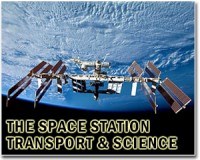 |
Houston TX (SPX) Apr 04, 2011 At 10:36 p.m. EDT, ground controllers moved the International Space Station away from a piece of orbital debris. The object is a relic from a collision between the COSMOS 2251 and Iridium 33 satellites in February 2009 and had been close to the station's orbit prior to the debris avoidance maneuver (DAM). The DAM, performed during the Expedition 27 crew sleep period, used thrusters from three spacecraft, the European Space Agency's Johannes Kepler Automated Transfer Vehicle 2 (ATV2), the Zvezda service module and Progress 41P. Mission Control Center had been monitoring a series of conjunctions between the International Space Station and the orbital debris. The Expedition 27 crew was informed of the possible conjunction and planned maneuver. While the Mission Control Center planned the debris avoidance maneuver, the three-member Expedition 27 crew continued preparing for the upcoming arrival of three more crew members on Soyuz 26 following Monday's launch of NASA astronaut Ron Garan, and Russian cosmonauts Andrey Borisenko, and Alexander Samokutyaev from the Baikonur Cosmodrome in Kazakhstan, and for the upcoming STS-134 mission of space shuttle Endeavour. The maneuver is not expected to significantly affect the launch time for the Soyuz TMA-21 on April 4 at 6:18 p.m. EDT, or the April 19 launch of Endeavour. Expedition 27 Flight Engineer Paolo Nespoli worked in the International Space Station's Quest airlock Friday, checking out one of the Simplified Aid for EVA Rescue (SAFER) systems that will be used during STS-134. Essentially a "life jacket" for spacewalks, SAFER is a self-contained maneuvering unit that is worn like a backpack. The system relies on small nitrogen-jet thrusters that can be used should an astronaut somehow drift away from the complex. Nespoli also configured other spacewalk tools, including cameras, tethers and equipment bags. Astronaut Cady Coleman, also a flight engineer, continued working with the Nanoskeleton experiment, which looks at the effect of gravity on oil flotation, sedimentation and convection on crystals generated in microgravity. This could aid in the development of lighter, stronger materials. She also worked with Nespoli in preparing the Quest airlock for the upcoming spacewalks. Commander Dmitry Kondratyev performed some routine maintenance removing and replacing dust filters in the Poisk module and testing software on one of the stations laptops. At the Baikonur Cosmodrome in Kazakhstan, Garan , Borisenko and Samokutyaev continued preparations for their journey to the orbital complex where they will join the Expedition 27 crew as flight engineers. Their Soyuz TMA-21 spacecraft, named for Yuri Gagarin, is scheduled for liftoff on Monday (Tuesday, local time), just one week shy of the 50th anniversary of Gagarin's historic journey into space from that same launch pad at the Baikonur Cosmodrome. Space shuttle Endeavour is slated to lift off on April 19 to begin the STS-134 mission. The orbiter will deliver the Alpha Magnetic Spectrometer and spare parts including two S-band communications antennas, a high-pressure gas tank, additional spare parts for the Dextre robotic manipulator and micrometeoroid debris shields. This will be the 36th shuttle mission to the International Space Station and the final flight for Endeavour. Read more about Expedition 27
Share This Article With Planet Earth
Related Links Station at NASA Station at NASA Station and More at Roscosmos S.P. Korolev RSC Energia Watch NASA TV via Space.TV Space Station News at Space-Travel.Com
 Russian Soyuz set for Tuesday launch
Russian Soyuz set for Tuesday launchBaikonur, Kazakhstan (UPI) Apr 3, 2011 A Russian Soyuz spacecraft has been transported to its launch pad in Kazakhstan in advance of its Tuesday blastoff for a manned mission into space. The Chinese news agency Xinhua reported the Soyuz was delivered to the launch site and raised to a vertical position at the launch site Saturday despite inclement weather. The Soyuz TMA-21 will rocket three crew members - U.S. astron ... read more |
|
| The content herein, unless otherwise known to be public domain, are Copyright 1995-2010 - SpaceDaily. AFP and UPI Wire Stories are copyright Agence France-Presse and United Press International. ESA Portal Reports are copyright European Space Agency. All NASA sourced material is public domain. Additional copyrights may apply in whole or part to other bona fide parties. Advertising does not imply endorsement,agreement or approval of any opinions, statements or information provided by SpaceDaily on any Web page published or hosted by SpaceDaily. Privacy Statement |